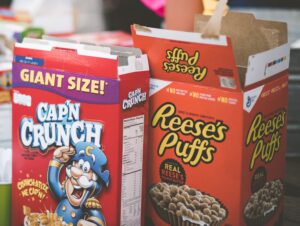- Write percents and perform calculations
- Determine unit rate using percentages
- Find both the relative and absolute change
Breakfast Crunch: Crunching Numbers Over Cereal
The smell of freshly brewed coffee and the sound of birds singing outside signal the start of a beautiful Saturday morning. You’re looking forward to a relaxing breakfast with your favorite cereal, but oh no! The box is almost empty. This seemingly mundane situation, however, offers an excellent opportunity to put your math skills into practice. Let’s take this day as an opportunity to delve into percentages, unit prices, relative and absolute change, and even some volume calculations. Ready? Let’s get started!

The box of cereal left on the shelf is listed as containing [latex]10.5[/latex] ounces of cereal. After measuring, you notice there are only [latex]3[/latex] ounces left.
After a delicious but slightly meager breakfast, you decide it’s time for a grocery run. While there, you find yourself in the cereal aisle, contemplating different box sizes of your favorite brand. There’s more to consider here than just the price – you’re thinking about unit prices, absolute, and relative changes in quantities.
You’re comparing two boxes of cereal: the [latex]18.6[/latex]-ounce box costs [latex]$5.29[/latex], and the [latex]26.1[/latex]-ounce box costs [latex]$6.49[/latex].
You notice there’s a wider range of box sizes than you initially thought. The smallest box is [latex]10.5[/latex] ounces and the largest box is [latex]32[/latex] ounces.